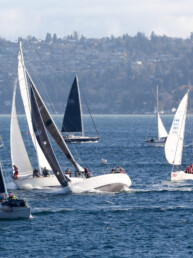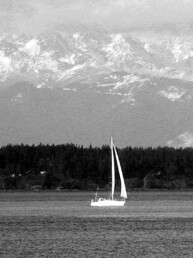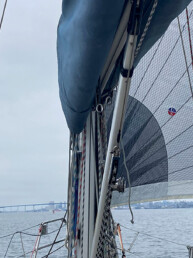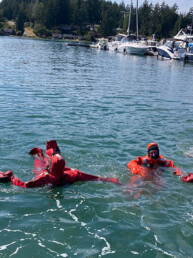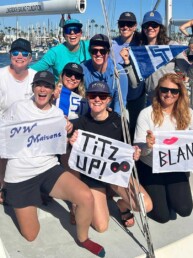Sailing has been the center of my life for as long as I can remember. My earliest memories are of feeling the cool Pacific Northwest wind kissing my face, the smell of teak being sanded, the ocean sparkling when the afternoon sun hit it just right. Through my experiences sailing, traveling, working, and observing, I have developed a deep appreciation for how diverse my path in sailing has been, and the ways this variety has bettered me. Further, I have witnessed the importance of broad, varied experiences for other sailors. While some conventional wisdom suggests that specialization is the best track for kids who are passionate and serious about sailing, that certainly hasn’t been my story.
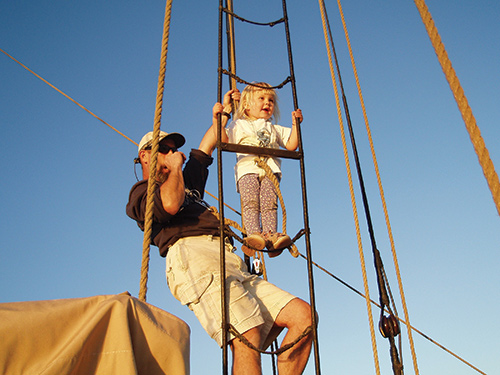
I first went sailing just three weeks after I was born. My parents are the primary caretakers for the 84-foot schooner Martha; a classic sail training vessel based out of Port Townsend, Washington. When they would go to work on the boat, I came along as well. The big floor of a sail loft made the perfect playground for a toddler, a cup of water and a paint brush provided ideal entertainment, and the cozy corner of a bunk was a great nap spot as the boat sailed to new destinations. No doubt, this background offered more than my share of extraordinary opportunities — I turned 3 years old while cruising in Mo’orea on Alcyone, a different schooner. I helped sail Martha to Hawaii in the Transpac Race in 2015; and I have been involved in every aspect of Martha’s life from sail training to the maintenance and upkeep of a 115-year-old wooden vessel.
You might think that these experiences on large, traditional vessels would mean those would be my chosen craft forever. Instead, these experiences were eye opening and helped guide me down a path of continuing to sail, and I quickly fell in love with dinghy racing and all it had to offer.
Despite my family’s love for sailing, I didn’t truly begin sailing dinghies until my freshman year of high school. I will never forget my first practice on the team; it was as if something clicked and suddenly unlocked a whole new love for sailing. All the principles I had learned from sailing and racing bigger boats were the same, but everything was on a scale that offered more control and an intimate connection with the wind and waves.
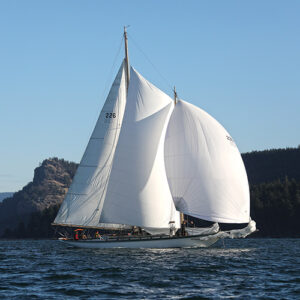
Up to this point, I had assumed that I would always sail classic boats, and that my path was already laid. I had never stopped to think about the possibilities that I never even knew existed. These possibilities came in the form of countless capsizes, learning the importance of proper vang use in 25 knots of wind, cold wetsuits, sleepy car rides to regattas, trying and failing to port tack the fleet at a windward mark, and ultimately discovering a sport and a group of people that have changed my life forever. It was incredibly intimidating at first, trying to jump into a world that felt so different and new…or so I thought. Not only did I quickly learn how to apply my sailing skills and understanding in this new pursuit, but it was invigorating to see that my fellow sailors shared my passion for sailing even though our backgrounds were very different. I had braced for a painfully slow transition, but it felt more like taking a step in a similar, but fresh, direction.
I quickly began filling all my free time with dinghies. The summer before my junior year, I decided to branch out from Lasers and FJs and attempt to sail 29ers. I am beyond lucky to have a family who is supportive in my journeys, and due to the lack of 29ers in our area, we drove to San Francisco to pick up a boat that a friend and I decided to buy from a former coach.
By this time, I was working as a youth sailing instructor, coaching dinghy racing and doing my best to pass along a love for sailing and for the ocean. I have worked, and still work, with some of the most amazing kids, and it is my goal to help them see that they can pursue many different avenues in sailing, not just one standardized path.
It is common to hear that there is only one way to become a successful sailor or coach, or that you have to “pick” big boats or dinghy sailing. Some kids are told that the only path to success is in Optimist or Sabot dinghies, and then to age up into different boats. Even in the world of traditional boats, there is a conventional approach — one that tends to focus on a young person’s journey through responsibilities on a large, crewed vessel rather than exploring racing or small boat sailing in (gasp) fiberglass or carbon boats. While there are plenty of success stories and many important truths to these sentiments, they all represent a limiting message to pass on to young sailors, and they are in direct contrast to what I value in my experience. Sailing has something for everyone, and it’s possible that lots of sailors would thrive if given encouragement to branch out beyond whichever sailing avenue they started in.
There is not one pathway to success, nor one “correct” way to love and interact with sailing. Strict categorizations can make sailing and sailors feel unrelated or even at odds with one another. There are often cultural rules and assumptions about who can do what. “If you sail classic boats, you don’t know how to race.” Or, “High school sailing will put you on a perfect path for college racing, but not skiffs.” The list goes on. There is no doubt that the more time you spend focusing on one discipline, the more proficient you will become. If we look at the best sailors in different classes, there is a clear pattern between an area of focus and the highest levels of success. Any sailor must devote the majority of time to one boat if they are attempting to race in the Olympics or run the bow on a TP52 Super Series yacht one day. However, a diverse experience isn’t the enemy of proficiency or success. And I believe this variety is an investment in the creation of a well-rounded and life-long love of sailing.
One of the best examples of success in a broad understanding of sailing is Brazilian sailor Martine Grael. She is a two-time Olympic champion in the 49erFX and also competes in the The Ocean Race (formerly the Volvo Ocean Race). She has proven her proficiency in two very different racing settings, and one can only imagine the skills and understanding she benefits from across these two pursuits.
Likewise, though clearly on a different scale, much of my life currently revolves around dinghies, but I find that the contrast of offshore sailing provides profound excitement and learning for inshore racing and coaching. Offshore sailing taught me a deep respect for the ocean and what it can do. The raw power that the ocean holds, as well as all its beauty and all its mysteries are something that you can not truly feel until you are alone with it. I have never felt afraid of the ocean, but I will always be aware that it is much bigger than I am, and I must respect it and never underestimate it. While there’s no replacement for experiencing offshore sailing yourself, I try to share my perspectives with the kids I coach. I find that it is something they can understand on a foundational level, as they too are building their experiences with sailing and the ocean — however protected the waters or short the courses seem.
“I believe many sailors will be surprised (as I was) to find how much of your knowledge and skills can be easily and enjoyably applied in new environments.”
Sailing big boats also taught me patience. It taught me how to play the long game, and to slow things down for long term results. Conversely, dinghy racing taught me how to make quick decisions and be precise in a fast-paced environment. An understanding of the different skill sets has been surprisingly beneficial in both situations. Of course, it can take time to separate some of the theories that don’t translate seamlessly between big and small boat racing. During my freshman year on the high school sailing team, it took my coach many trying practices to help me to understand why sailing “schooner brained” upwind (the tendency to sail long legs to one corner of the race course instead of tacking more often) in an FJ was going to kill my race.
Even within much more related avenues, varied experiences add depth, excitement, and layers to sailing ability and knowledge that can enhance a parallel sailing activity. When I began sailing 29ers, a coach explained that, “after you sail 29ers, and are used to going fast for a while; when you get back in an FJ and go to round a leeward mark, time will feel like it’s slowed down and you’ll be able to execute maneuvers so well.”
I have friends who are extremely talented dinghy sailors, but have never set foot on a boat bigger than 20 feet. I often hear that they would love to sail keelboats, but they don’t know how to start. Similarly, I know people who are incredibly accomplished in the world of traditional sailing but they’ve never had any racing experience. There is nothing wrong with loving the way you currently go sailing! However, leaning into new experiences in sailing can only fuel your passion and deepen your understanding of its many intricacies.
Fear of the unknown can be a hurdle, “If I’ve only sailed dinghies, will I understand what is happening on a keelboat?” I encourage you to step outside of your comfort zone and give it a try. It can be scary to step onto a new boat, especially if you feel as if you are coming from a different world. Yet, I believe many sailors will be surprised (as I was) to find how much of your knowledge and skills can be easily and enjoyably applied in new environments. And just as important, I’m confident you’ll find a common love for sailing among these other sailors, even on intimidatingly dissimilar boats.
Martha participates in two of the Pacific Northwest’s biggest and most storied races each year: Swiftsure and Round the County. These races are often dominated by modern boats with the sole purpose of getting around a race course as quickly as possible. As you can imagine, an 84-foot wooden schooner looks rather out of place on a start line full of fiberglass and carbon fiber racing machines. While weight savings are of the utmost importance for the performance of many modern designs, we stay warm in the Washington winter with a Dickinson diesel range heating our cozy mahogany interior. Our rigs and sailplans are certainly different — we have more sails and moving parts, and this creates the need for a larger crew. We are not as maneuverable, and there have been years that we have had to make drastically different tactical decisions than a majority of the fleet to minimize maneuvers or avoid a tacking battle. These seemingly stark differences, while comical at times, are not a barrier to being competitive on the racecourse. Moreover, they represent all that we sailors share: a course, an activity, and a high regard for its many facets. This whole depiction resonates with me, because it seems to reflect so much about my own experience — that divergent aspects of boat design or sailing technique all blend modernity and tradition, that sailing is sailing is sailing, and that embracing the differences within the sailing world is actually a way to unite us as sailors.
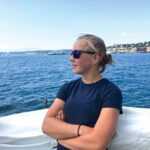
Growing up in Port Townsend, spending time on such different boats, cruising and racing both inshore and offshore, and doing it all at a young age has helped me become who I am today. Recognizing that I am fortunate to have had a such a unique background in sailing, I do my best to inspire those I coach to think beyond conventional wisdom or tracks. It is my hope that young sailors are given the opportunity to love sailing in whatever ways suit them best. To foster this goal, I try to create opportunities for them to go sail just for fun — practice days with no pressure attached, and time on the water just to play or to experience the beauty and fun of the ocean. I encourage sailing on other boats, whether it’s cruising with family or racing on a different type of design. I want my sailors, all sailors really, to know they are not limited in their options and their future. If you love sailing, keep doing it in every way that interests you. The more variety, the better.
Mary d’Arcy lives and coaches in San Diego, California. She is in her second year of college, attending Southern New Hampshire University remotely.

